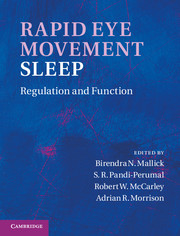Book contents
- Frontmatter
- Contents
- Contributors
- Preface
- Acknowledgments
- Organization
- Section I Historical context
- Section II General biology
- Section III Neuronal regulation
- Section IV Neuroanatomy and neurochemistry
- 19 Aminergic influences in the regulation of basic REM sleep processes
- 20 REM sleep regulation by cholinergic neurons: highlights from 1999 to 2009
- 21 GABAergic modulation of REM sleep
- 22 Glutamatergic regulation of REM sleep
- 23 The role of tuberomammillary nucleus histaminergic neurons, and of their receptors, in the regulation of sleep and waking
- 24 Hypocretinergic system: role in REM-sleep regulation
- 25 Neuropeptides and REM sleep
- 26 Adenosine and glycine in REM-sleep regulation
- 27 Changes in neurotransmitter levels in relation to REM sleep for its regulation
- 28 Pontine areas inhibiting REM sleep
- 29 Neuronal models of REM-sleep control: evolving concepts
- Section V Functional significance
- Section VI Disturbance in the REM sleep-generating mechanism
- Index
- Plate section
- References
29 - Neuronal models of REM-sleep control: evolving concepts
from Section IV - Neuroanatomy and neurochemistry
Published online by Cambridge University Press: 07 September 2011
- Frontmatter
- Contents
- Contributors
- Preface
- Acknowledgments
- Organization
- Section I Historical context
- Section II General biology
- Section III Neuronal regulation
- Section IV Neuroanatomy and neurochemistry
- 19 Aminergic influences in the regulation of basic REM sleep processes
- 20 REM sleep regulation by cholinergic neurons: highlights from 1999 to 2009
- 21 GABAergic modulation of REM sleep
- 22 Glutamatergic regulation of REM sleep
- 23 The role of tuberomammillary nucleus histaminergic neurons, and of their receptors, in the regulation of sleep and waking
- 24 Hypocretinergic system: role in REM-sleep regulation
- 25 Neuropeptides and REM sleep
- 26 Adenosine and glycine in REM-sleep regulation
- 27 Changes in neurotransmitter levels in relation to REM sleep for its regulation
- 28 Pontine areas inhibiting REM sleep
- 29 Neuronal models of REM-sleep control: evolving concepts
- Section V Functional significance
- Section VI Disturbance in the REM sleep-generating mechanism
- Index
- Plate section
- References
Summary
Summary
In this chapter, we will review the recent developments relevant to understanding the neural systems that regulate REM sleep. We will review the initial discovery of REM sleep, followed by a brief description of the polysomnographic characterization of REM sleep. Our discussion will continue with a review of the principal brain-stem executive neurons responsible for REM generation. Pontine reticular formation neurons are involved in the expression of the majority of REM-sleep phenomena, including low-amplitude/high-frequency cortical EEG, the hippocampal theta rhythm, PGO waves/P-waves, and muscle atonia. Cholinergic brain-stem neurons are REM-on, promoting REM sleep; and serotonergic and noradrenergic brain-stem neurons are REM-off, suppressing REM sleep. GABAergic and glutamatergic mechanisms are also integral to REM sleep control. We will also survey the prominent nuclei of the midbrain and forebrain that promote, but do not generate, REM-sleep expression. The conclusion of this chapter will provide a review of three prominent models of REM-sleep regulation: the reciprocal-interaction model; the REM sleep “flip-flop” circuit model; and the revised model of paradoxical (REM) sleep control proposed by Luppi and colleagues.
- Type
- Chapter
- Information
- Rapid Eye Movement SleepRegulation and Function, pp. 285 - 300Publisher: Cambridge University PressPrint publication year: 2011

